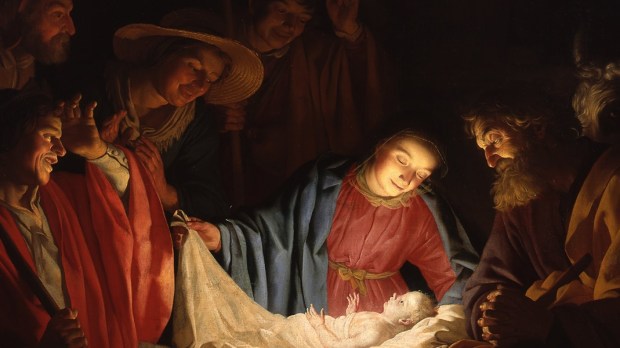“On December five-and-twenty, fum fum fum,” runs the old Christmas carol.
“Only X shopping days until Christmas!”
December 25 is so ingrained into our conception of Christmas that it’s hard to think of the date without mental images of Santa Claus and decorated trees. But was that the actual date upon which Jesus was born? And if we don’t know, why did the Church settle on that date as the anniversary?
The evidence from the Gospel accounts is sparse: According to Luke, for example, angels announced the birth to a group of shepherds. But would shepherds be out in the fields in the middle of winter? Luke 2:8 “might suggest the spring lambing season,” writes Andrew McGowan, Dean and President of the Berkeley Divinity School at Yale University, at Bible History Daily. “In the cold month of December, on the other hand, sheep might well have been corralled.”
Was December 25 chosen, as some have suggested, in order to provide an alternative to pagan celebrations such as Saturnalia, Sol Invictus or Mithras? McGowan is skeptical:
Despite its popularity today, this theory of Christmas’s origins has its problems. It is not found in any ancient Christian writings, for one thing. Christian authors of the time do note a connection between the solstice and Jesus’ birth: The Church father Ambrose (c. 339–397), for example, described Christ as the true sun, who outshone the fallen gods of the old order. But early Christian writers never hint at any recent calendrical engineering; they clearly don’t think the date was chosen by the Church. Rather they see the coincidence as a providential sign, as natural proof that God had selected Jesus over the false pagan gods.
Clement of Alexandria, writing in 200, acknowledged that there had already been several different dates proposed, such as April 20 or 21 or May 20. He didn’t mention December 25.
According to Jon Sorenson of Catholic Answers, Hippolytus of Rome explains in his Commentary on the book of Daniel (c. 204) that Jesus’ birth was believed to have occurred on December 25. Hippolytus writes:
For the first advent of our Lord in the flesh, when he was born in Bethlehem, was December 25th, Wednesday, while Augustus was in his forty-second year, but from Adam, five thousand and five hundred years. He suffered in the thirty-third year, March 25th, Friday, the eighteenth year of Tiberius Caesar, while Rufus and Roubellion were Consuls.
According to another of Hippolytus’ works, the Chronicon, Jesus was born nine months after the anniversary of Creation. “According to his calculations, the world was created on the vernal equinox, March 25, which would mean Jesus was born nine months later, on December 25,” says Sorenson.
McGowan says that by the 4th century, “we find references to two dates that were widely recognized—and now also celebrated—as Jesus’ birthday: December 25 in the western Roman Empire and January 6 in the East (especially in Egypt and Asia Minor).”
But wait. Hippolytus writes that Christ “suffered in the thirty-third year, March 25?” So is he saying that we also know the exact date of Good Friday, the day of Jesus’ crucifixion?
“Strange as it may seem, the key to dating Jesus’ birth may lie in the dating of Jesus’ death at Passover,” McGowan writes. “This view was first suggested to the modern world by French scholar Louis Duchesne in the early 20th century and fully developed by American Thomas Talley in more recent years. But they were certainly not the first to note a connection between the traditional date of Jesus’ death and his birth.”
McGowan explains that according to the Gospel of St. John, Jesus is crucified as the Passover lambs are being sacrificed. “This would have occurred on the 14th of the Hebrew month of Nisan, just before the Jewish holiday began at sundown (considered the beginning of the 15th day because in the Hebrew calendar, days begin at sundown),” McGowan writes. “In Matthew, Mark and Luke, however, the Last Supper is held after sundown, on the beginning of the 15th. Jesus is crucified the next morning—still, the 15th.”
Tertullian of Carthage, around the year 200, reported the calculation that the 14th of Nisan was equivalent to March 25 in the Roman calendar. That date was later recognized as the Feast of the Annunciation—nine months before December 25.
And Pope Benedict XVI, in his 2000 book The Spirit of the Liturgy, affirms this connection. “The decisive factor [in setting the date for Christmas] was the connection of creation and Cross, of creation and Christ’s conception,” Benedict wrote, when he was still known as Cardinal Joseph Ratzinger.
McGowan says that in the Christian East, the dates of Jesus’ conception and death also were linked. “But instead of working from the 14th of Nisan in the Hebrew calendar, the easterners used the 14th of the first spring month (Artemisios) in their local Greek calendar—April 6 to us,” he writes. “April 6 is, of course, exactly nine months before January 6—the eastern date for Christmas.”
In the East, too, we have evidence that April was associated with Jesus’ conception and crucifixion. Bishop Epiphanius of Salamis writes that on April 6, “The lamb was shut up in the spotless womb of the holy virgin, he who took away and takes away in perpetual sacrifice the sins of the world.” Even today, the Armenian Church celebrates the Annunciation in early April (on the 7th, not the 6th) and Christmas on January 6.

